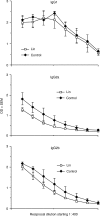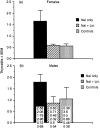Effect of the synthetic immunomodulator, linomide, on experimental models of thyroiditis
- PMID: 10233714
- PMCID: PMC2326756
- DOI: 10.1046/j.1365-2567.1999.00713.x
Effect of the synthetic immunomodulator, linomide, on experimental models of thyroiditis
Abstract
The drug Linomide is an immunomodulator showing marked down-regulation of several experimental autoimmune diseases. In this study, its effect on three different experimental models of thyroid disease and on spontaneous infiltration of salivary glands (sialoadenitis), was investigated. Although very effective at preventing thyroid infiltrates in mice immunized with mouse thyroglobulin and complete Freund's adjuvant and in spontaneous models of thyroiditis and sialoadenitis, it completely failed to modify experimental autoimmune thyroiditis (EAT) induced in mice immunized with mouse thyroglobulin and lipopolysaccharide. There was no significant shift in the observed isotypes of anti-mouse thyroglobulin antibodies and only anti-mouse thyroglobulin antibodies in the spontaneous model were completely down-modulated by the drug. One surprising fact to emerge was that Linomide-treated donor mice, although protected from thyroid lesions themselves, were still able to transfer EAT showing that they must have been effectively primed while being treated with Linomide. It is possible that the drug down modulated EAT by interfering with the trafficking of primed effector cells.
Figures









Similar articles
-
Effect of the traditional Korean immunomodulating formulation, Gamguntang (GGT), on experimental thyroiditis model.Immunopharmacol Immunotoxicol. 2006;28(1):51-66. doi: 10.1080/08923970600625694. Immunopharmacol Immunotoxicol. 2006. PMID: 16684667
-
Autoimmune thyroid disease induced by thyroglobulin and lipopolysaccharide is inhibited by soluble TNF receptor type I.Eur J Immunol. 2002 Apr;32(4):1021-8. doi: 10.1002/1521-4141(200204)32:4<1021::AID-IMMU1021>3.0.CO;2-X. Eur J Immunol. 2002. PMID: 11920568
-
Linomide does not prevent spontaneous autoimmune thyroiditis in NOD mice.Autoimmunity. 2001;33(2):79-84. doi: 10.3109/08916930108995992. Autoimmunity. 2001. PMID: 11264786
-
The immunomodulator Linomide: role in treatment and prevention of autoimmune diabetes mellitus.Int Immunopharmacol. 2001 Jun;1(6):1131-9. doi: 10.1016/s1567-5769(01)00042-x. Int Immunopharmacol. 2001. PMID: 11407307 Review.
-
Linomide, a new treatment for autoimmune diseases: the potential in type 1 diabetes.Diabetes Metab Rev. 1993 Dec;9(4):311-5. doi: 10.1002/dmr.5610090411. Diabetes Metab Rev. 1993. PMID: 7924828 Review. No abstract available.
References
-
- Dawe K, Hutchings PR, Champion B, Cooke A, Roitt IM. Autoantigens in thyroid disease. Springer Semin Immunopathol. 1993;14:285. - PubMed
-
- Flynn JC, Conaway DH, Cobbold S, Waldmann H, Kong Y-C.M. Depletion of L3T4+ and Lyt-2+ cells by rat monoclonal antibodies alters the development of adoptively transferred experimental autoimmune thyroiditis. Cell Immunol. 1989;122:377. - PubMed
-
- Damotte D, Colomb E, Cailleau C, Brousse N, Charreire J, Carnaud C. Analysis of susceptibility of NOD mice to spontaneous and experimentally induced thyroiditis. Eur J Immunol. 1997;27:2854. - PubMed
Publication types
MeSH terms
Substances
LinkOut - more resources
Full Text Sources
Medical

